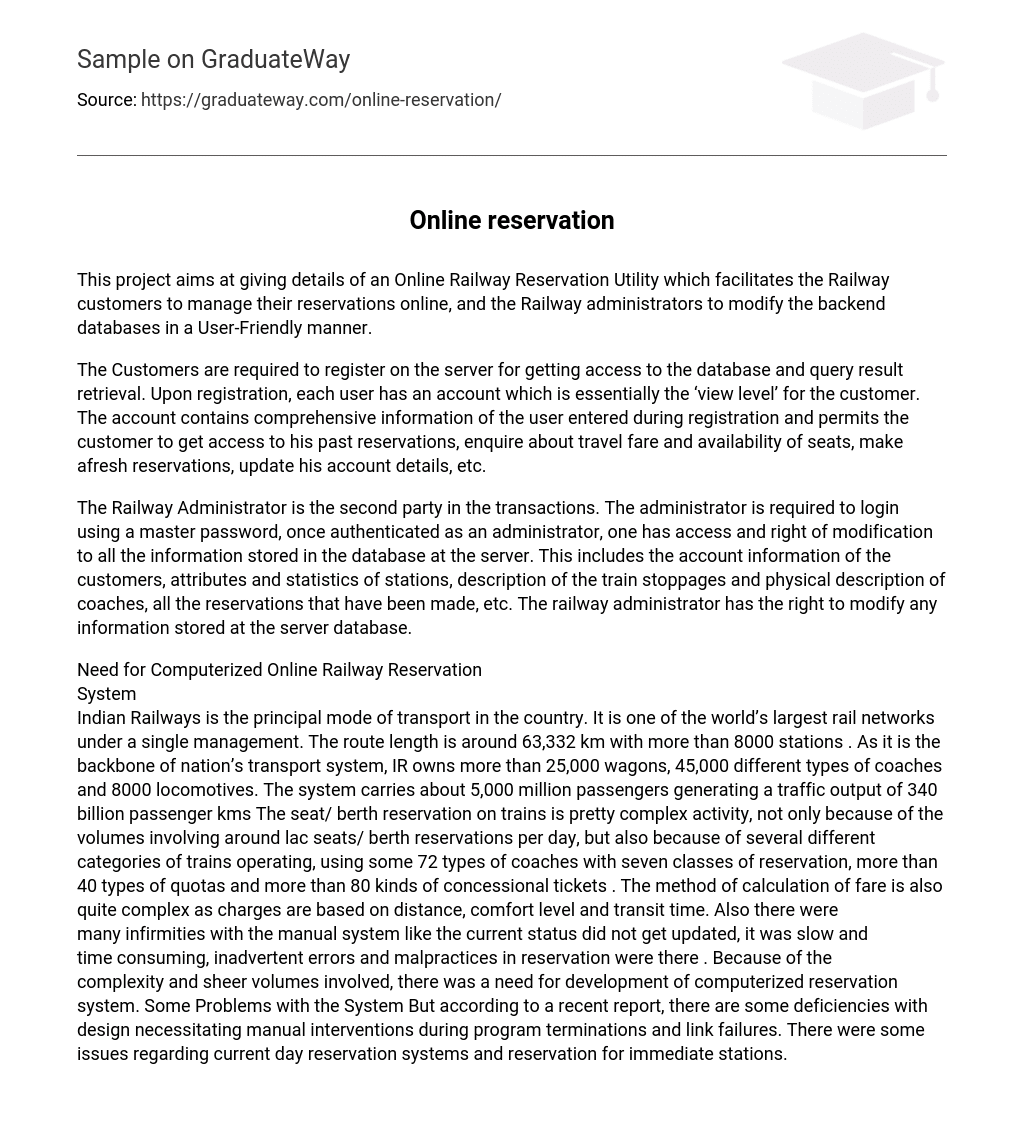The purpose of this project is to provide information about an Online Railway Reservation Utility. This utility allows Railway customers to manage their reservations online and enables Railway administrators to easily modify the backend databases.
The Customers must register on the server to access the database and retrieve query results. After registration, each user has an account that serves as the “view level” for the customer. This account includes all the information provided by the user during registration and allows them to view past reservations, inquire about travel fare and seat availability, make new reservations, update their account details, etc.
The Railway Administrator, as the second party in the transactions, needs to authenticate their login by using a master password. Upon successful login, they are granted access and permission to modify all data stored in the server’s database. This encompasses customer account details, station attributes and statistics, train stoppage descriptions, physical descriptions of coaches, and reservations. The railway administrator holds complete authority to alter any information within the server’s database.
The online railway reservation system is needed due to the significance of Indian Railways as the primary mode of transportation in India. With a vast rail network spanning over 63,332 km and more than 8000 stations, Indian Railways plays a crucial role in the country’s transport system. To support this extensive network, IR maintains a fleet of over 25,000 wagons, 45,000 different types of coaches, and 8000 locomotives. However, the complexity of seat/berth reservation on trains arises from the high volume of reservations, which can reach around one lac per day. There are numerous categories of trains including 72 types of coaches and seven classes of reservation. Additionally, there are over 40 types of quotas and more than 80 types of concessional tickets. Calculating fares adds another layer of complexity as charges depend on distance, comfort level, and transit time.
However, the current manual reservation system has various shortcomings including delays in updating reservation status, inefficient and time-consuming processes, inadvertent errors, and instances of malpractice. Due to the intricacy and magnitude involved in managing reservations effectively , a computerized reservation system is necessary. Nevertheless a recent report highlights certain issues with the computerized reservation system that require manual interventions when the program terminates or experiences link failures.The flaws mainly impact the reservation systems for booking stations on the same day and immediately.
The coaching refund system lacked integration, and there were deficiencies in both physical and logical access controls. System documentation, IT security practices, change management, and disaster recovery policy were inadequate general controls. There were also deficiencies in physical and logical access controls. A high number of users had supervisory privileges, and booking clerks were routinely given these privileges, which posed a risk of potential misuse.
The change management mechanism was ineffective, resulting in untimely incorporation of policy changes in the system software. Additionally, a structured disaster recovery policy was nonexistent, leading to insufficient maintenance and protection of infrastructure and data.
The presence of weak application controls led to the booking of a number of tickets using fake information. This suggests that there were fraudulent bookings made in advance, resulting in a decrease in the number of seats available for actual passengers.
The system lacked strong validation checks for generating pre-bought tickets for journeys with multiple laps. It allowed the generation of a ticket with zero value for the second lap without generating a ticket for the first lap. Additionally, seats/berths were blocked for dummy passengers who used the pre-bought facility.
The lack of validation checks in the application software led to non-compliance with break journey rules and mismanagement of various quotas for train accommodation. As a result, there was a decrease in seat availability for the general public and a loss of revenue for the Railways.
Incorrect adoption of fares and distances resulted in incorrect fare levies. The electronic databases had numerous deficiencies, making the data unreliable.
Despite the intention for berths allotment to be error-free, multiple occurrences were observed where the system assigned the same berths to different passengers.
Trains and stations were inaccurately defined in the system, preventing accommodation reservations. Delays in updating the status of late-running trains caused incorrect refunds to be issued to passengers.
The custody and utilization of ticket rolls had a weak internal control mechanism, making them vulnerable to misuse.





